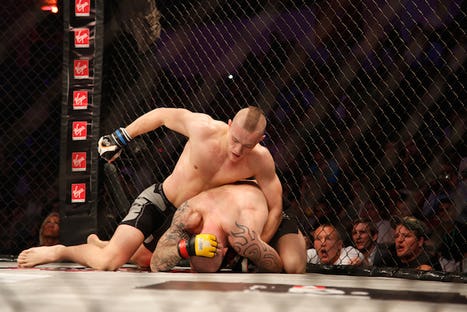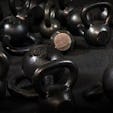Trainer Corey Beasley trains a host of professional MMA fighters out of his unconventional gym in Orange County. He knows how hard MMA fighters push themselves to perform; he also knows the most common workout mistakes they make when trying to be the best. Fortunately, he has the solution.
These days it seems like MMA is everywhere! TV, magazines, clothing, gyms and more. Mixed martial arts has evolved into the fastest growing sport in the world, but I believe it is still in its infancy and athletes (coaches) are still trying to figure out the best way to juggle all the aspects of training needed to compete.
MMA is a complex sport that involves many different art forms. Fighters are forced to balance all aspects of their fight training, including boxing, Muay Thai, kickboxing, wrestling, jiu jitsu, drilling, technique, sparring and more. On top of this, they also need to fit some type of strength and conditioning plan, pay their bills, eat, sleep, and manage to squeeze in a personal life (family, friends, kids, etc).
 Bottom line: there is a lot to deal with and overtraining is a huge problem.
Bottom line: there is a lot to deal with and overtraining is a huge problem.
In other professional sports, like the NFL or the NBA, athletes are guided through very specific workouts, practices, recovery techniques, nutrition plans, and more. There are millions of dollars riding on their performances and they do everything possible to perform at the highest level.
I spoke with a Pro Bowl Linebacker from the New England Patriots, he said “There are 50 guys competing for my position every year. They are younger, faster and hungry. I have to stay on top of my training all year, or I will be out of a job.”
I had a new guy come in this morning. He is relatively new to the sport and said that he sparred in the morning, had jiu jitsu after, went for a four mile run, then lifted weights at night. I like his ambition but he is asking for disaster.
So, without going into the all the details of training, I am going to explain the three main mistakes that I see MMA athletes make during their training.
Mistake #1: Ego Driven, Adrenaline Junkie Workouts
 MMA fighters do a high volume of work every week. Drilling, sparring, mitts, bag work, and other aspects are intense and they are all taxing on the body. If you are going to add a strength and conditioning plan on top of that volume of work, it has to be well thought out and compliment an existing plan. Way too many trainers, athletes, and coaches create programs from scratch, hearsay, YouTube videos, or past experience. Their main goal is simply to work hard, without taking other aspects of the fighters’ training or life into consideration. John Hinds said, “Any trainer can crush you, but only the good ones can heal you as well.”
MMA fighters do a high volume of work every week. Drilling, sparring, mitts, bag work, and other aspects are intense and they are all taxing on the body. If you are going to add a strength and conditioning plan on top of that volume of work, it has to be well thought out and compliment an existing plan. Way too many trainers, athletes, and coaches create programs from scratch, hearsay, YouTube videos, or past experience. Their main goal is simply to work hard, without taking other aspects of the fighters’ training or life into consideration. John Hinds said, “Any trainer can crush you, but only the good ones can heal you as well.”
If a fighter has been doing two workouts per day for a month straight, has poor nutrition, doesn’t sleep much, and is stressed out, the last thing he needs is a ball-busting, crusher workout that is just going to break him down even more. Remember, these guys are punching each other in the face, taking each other down, and tying each other into knots. They are always banged up somewhere.
So, my philosophy is this: vary workout intensities based on the fighter’s ability level, training load, lifestyle, and fight training schedule. I split my workouts into three groups: red, yellow, and green. I learned this simple system from Geoff Myers, who has become an invaluable part of our team. Here’s a quick breakdown:
Red MMA Workout
This is an anaerobic, high intensity type workout that everybody loves. They are usually shorter workouts with intense bursts of effort. The fighters’ heart rates are high, lactic acid builds up quickly, and the intervals are typically 30 seconds or less.
Yellow MMA Workout
These workouts are still tough, but do not red line the athlete’s heart rate. They typically involve exercises lasting between 30 seconds and 5 minutes. They are medium intensity workouts or circuits; the athlete is working hard but can maintain their intensity for a period of time.
Green MMA Workout
These are a low intensity, longer duration workouts that last longer than 3 minutes. Common examples involve jogs, swimming, biking, light bodyweight drills, etc. The idea is basically to get the blood flowing and help the body recover. These types of workouts are great for homework.
By assessing the fighter’s training schedule, you can vary their workout intensity to help them make progress without overtraining. Remember, your goal with strength and conditioning should be to stimulate, not always annihilate.
Mistake #2: Train Hard, Train Often
The lack of sleep, improper nutrition, and short rest periods leave athletes tired, vulnerable to injury, and eventually burned out.
Along with varying training intensity, there are many other factors that affect a fighter’s performance and health. Stress reduction, proper nutrition, sufficient sleep, and other recovery techniques are vital to a fighter’s health and performance over time. Like I said before, most of these guys already train too much, are banged up, and are nursing some type of injury. The “more is better” mentality usually leaves them tired, injured, or burned out if it is not addressed.
The more they can do to speed recovery and avoid injury, the better.
Mistake #3: Lack of Consistency
Developing the skill, strength, speed, and conditioning for an elite athlete builds progressively over time. Too many fighters train for a few weeks leading up to a fight, then take a vacation for a month.
It’s the old rabbit and the hare analogy that everyone has heard, but very few actually apply. As MMA evolves, the “rabbits” will be exposed. Being talented or tough will only last so long and developing a consistent work ethic will separate the winners from the losers. Skill and strength are not built in a few weeks; it takes years to develop a foundation of strength and skill and constant tuning to develop that power into a refined champion.

)





